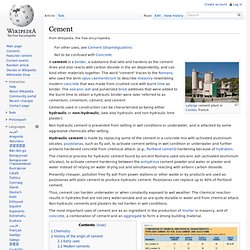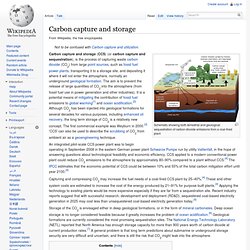

Cement. Cements used in construction can be characterized as being either hydraulic or non-hydraulic, (see also hydraulic and non-hydraulic lime plaster).

Non-hydraulic cement is prevented from setting in wet conditions or underwater, and is attacked by some aggressive chemicals after setting. Hydraulic cement is made by replacing some of the cement in a concrete mix with activated aluminium silcates, pozzolanas, such as fly ash, to activate cement setting in wet condition or underwater and further protects hardened concrete from chemical attack. (e.g., Portland cement) hardening because of hydration. The chemical process for hydraulic cement found by ancient Romans used volcanic ash (activated aluminium silicates), to activate cement hardening between the anhydrous cement powder and water or plaster and water instead of relying on water drying out and simultaeously reacting with airborn carbon dioxode. Thus, cement can harden underwater or when constantly exposed to wet weather. Chemistry[edit] Yhs-Wooten - Carbon Cycle. Carbon Capture & Sequestration.
ZEP - Safe Storage: Closing the carbon loop - CO2 Capture and Storage. Big Sky Carbon Sequestration Partnership. Safe Storage: Closing the carbon loop...

(ZEP, 2010) Carbon capture and storage is one method of moderating carbon dioxide (CO2) in our atmosphere while supporting our growing economic, human health and natural resource needs. More specifically, carbon capture, utilization and storage is the removal and long-term storage of CO2 from the atmosphere into carbon storage areas such as underground rock layers and terrestrial ecosystems.
Often, carbon capture and storage is abbreviated as CCS, or referred to as “carbon sequestration.” When carbon capture and storage has an enhanced fuel recovery component, it is referred to as carbon capture, utilization and storage, or CCUS. Learn more about the global CO2 emissions and the Intergovernmental Panel for Climate Change here. There are two types of carbon capture and storage: terrestrial CCS and geologic CCS.
In terrestrial CCS, carbon is stored in forests or in the soils of farmland, cropland, rangeland and other organic soils. Carbon sequestration. Carbon capture and storage. Schematic showing both terrestrial and geological sequestration of carbon dioxide emissions from a coal-fired plant An integrated pilot-scale CCS power plant was to begin operating in September 2008 in the eastern German power plant Schwarze Pumpe run by utility Vattenfall, in the hope of answering questions about technological feasibility and economic efficiency.

CCS applied to a modern conventional power plant could reduce CO2 emissions to the atmosphere by approximately 80–90% compared to a plant without CCS.[4] The IPCC estimates that the economic potential of CCS could be between 10% and 55% of the total carbon mitigation effort until year 2100.[4] Storage of the CO2 is envisaged either in deep geological formations, or in the form of mineral carbonates.
Deep ocean storage is no longer considered feasible because it greatly increases the problem of ocean acidification.[6] Geological formations are currently considered the most promising sequestration sites. Capture[edit] Carbon sequestration. Carbon sequestration is the process of capture and long-term storage of atmospheric carbon dioxide (CO 2)[1] and may refer specifically to: "The process of removing carbon from the atmosphere and depositing it in a reservoir.

"[2] When carried out deliberately, this may also be referred to as carbon dioxide removal, which is a form of geoengineering.The process of carbon capture and storage, where carbon dioxide is removed from flue gases, such as on power stations, before being stored in underground reservoirs.Natural biogeochemical cycling of carbon between the atmosphere and reservoirs, such as by chemical weathering of rocks.
Carbon sequestration describes long-term storage of carbon dioxide or other forms of carbon to either mitigate or defer global warming and avoid dangerous climate change. It has been proposed as a way to slow the atmospheric and marine accumulation of greenhouse gases, which are released by burning fossil fuels.[3] Biological processes[edit] Peat production[edit]